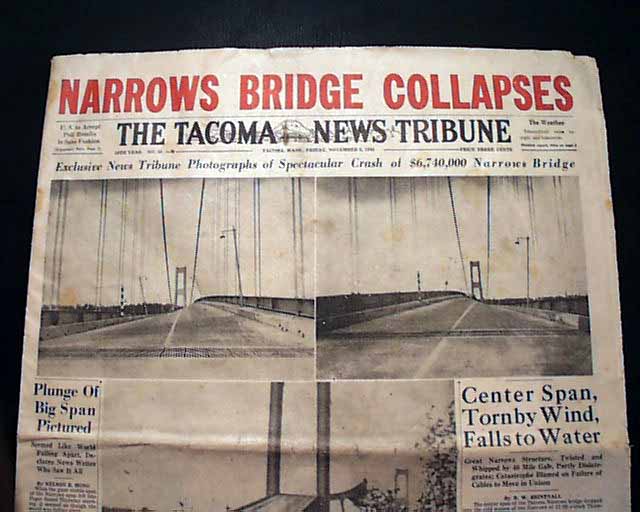Many of you live on the west side of Washington and are familiar with the Tacoma Narrows Bridge. The bridge crosses the Puget Sound between Tacoma and the Kitsap Peninsula. The state built the original bridge to help connect Tacoma to the navel ship yards in Bremerton along with McChord Field and Fort Lewis.
When the bridge opened in July 1940 it was the third longest suspension bridge in the world, behind the Golden Gate Bridge and the George Washington Bridge in New York.
But even during construction, workers were aware of how the wind played havoc with the road bed. In fact, they nicknamed the bridge “Galloping Gertie.” The name stuck. Four months later, on a windy November day, the bridge did a twisted, roller coaster dance before it collapsed into the water.
An editor with the Tacoma Tribune made the last trip over the bridge. Leonard Coatsworth had just driven past the bridge towers when the bridge started to shake violently. Coatsworth jammed on the brakes and jumped out of the car. He dropped to his hands and knees and crawled 500 feet to a tower.
“My breath was coming in gasps; my knees were raw and bleeding, my hands bruised and swollen from gripping the concrete curb…Toward the last, I risked rising to my feet and running a few yards at a time…Safely back at the toll plaza, I saw the bridge in its final collapse and saw my car plunge into the Narrows.” Leonard Coatsworth, Last man to cross the “Galloping Gertie.”
The media knew about the bridge’s flaws and when a 35-40 mph wind whipped through that day, they had a pretty good idea a story was in the making. (Perhaps that’s why a newspaper editor was driving across the bridge?) But in 1940, Chopper 5 didn’t exist; having your news team “live at the scene” couldn’t happen, posting pictures on the Internet would be impossible. In fact, it would be eight more years before KING-TV would even go on-the-air. (In 1948 they were just starting to rebuild the new bridge.)
Yes, the newspapers and radio covered the collapse. And the next weekend at the movie theater you could watch the bridge collapse newsreel. At the time media resources were limited.
COVERING BREAKING NEWS IN THE 1960s
Fast forward 28 years later. Walter Cronkite starts that evening’s edition of the CBS Evening News with breaking news. An assassin shot Martin Luther King.
Unlike the Tacoma Narrows Bridge Collapse, the media didn’t anticipate an assassination. While my former students working in the broadcast news industry can go “live” using an app on their phone, that didn’t exist back in 1968. “Live” shots were possible, but they took hours to set up. That’s why you don’t see a “live” shot from Memphis.
Another problem: Videotape had just come on the scene. The technology wouldn’t be available for several more years for shooting video in the field. So, stations shot the news on film. Before it could get on the air, someone had to develop the film. That took several hours, if it was a rush job. Microwave technology hadn’t been developed, so to get on the air, the film had to be transported to the station.
That’s why Walter read on camera for 1:20 before they cut to Lyndon Johnson’s reaction. I teach my television news students to leave the anchor on cam for 10 seconds… MAX.
Bottom line: Technology changed the way we cover the news. Now, head on back to Canvas and look up the Changing Technology assignment and follow directions.
